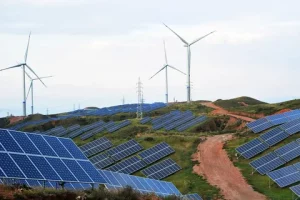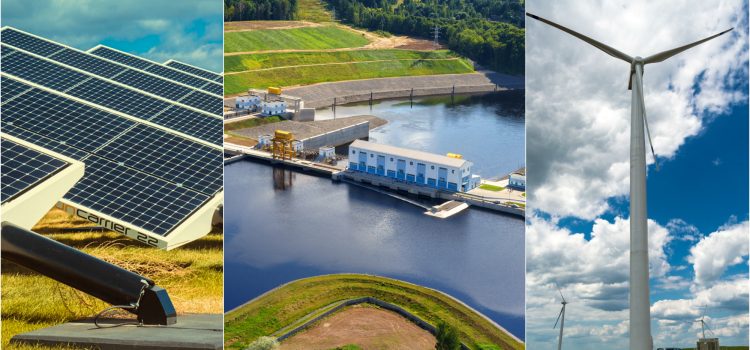
In recent years, the adoption of renewable energy adoption has surged, driven by technological advancements, policy initiatives, and a growing awareness of environmental issues. This article will delve into the key trends shaping the renewable energy landscape, focusing on solar power, wind energy, energy storage, and the role of government policies and corporate commitments.
Solar Power: The Leading Renewable Energy Source

One of the most significant trends in renewable energy adoption is the rapid growth of solar power. Technological advancements have made solar panels more efficient and affordable, leading to widespread adoption across residential, commercial, and industrial sectors.
Technological Innovations
Recent innovations in photovoltaic (PV) technology have significantly increased the efficiency of solar panels. For instance, bifacial solar panels, which can capture sunlight from both sides, have become increasingly popular. Additionally, the development of perovskite solar cells promises to further enhance efficiency and reduce costs.
Declining Costs
The cost of solar power has plummeted over the past decade, making it one of the most cost-effective sources of energy. According to the International Renewable Energy Agency (IRENA), the cost of solar PV electricity has fallen by 82% since 2010. This decline has been driven by economies of scale, improved manufacturing processes, and increased competition in the market.
Policy Support
Government policies have played a crucial role in promoting solar energy adoption. Incentives such as tax credits, feed-in tariffs, and net metering have made solar installations more attractive to consumers and businesses. Countries like China, the United States, and India have implemented ambitious solar energy targets, further boosting the sector.
Energy Storage: The Key to Renewable Energy Adoption
Energy storage is a critical component in the transition to renewable energy, addressing the intermittency and variability of sources like solar and wind.
Battery Storage
Battery storage technology has advanced significantly, with lithium-ion batteries leading the way. These batteries offer high energy density, long cycle life, and declining costs, making them ideal for storing renewable energy. Utility-scale battery storage projects are becoming more common, providing grid stability and enabling the integration of more renewable energy sources.
Alternative Storage Solutions
In addition to batteries, other energy storage solutions are gaining attention. Pumped hydro storage, compressed air energy storage, and thermal energy storage are some of the alternatives being explored. These technologies offer different advantages and can complement battery storage in creating a more resilient and flexible energy system.
Policy and Investment
Government policies and private sector investments are crucial in advancing energy storage technologies. Incentives such as grants, subsidies, and research funding have accelerated the development and deployment of energy storage solutions. Countries like the United States, China, and Germany are leading in energy storage capacity, driven by supportive policies and significant investments.
Wind Energy: Harnessing the Power of Nature

Wind energy is another key player in the renewable energy sector, with significant advancements in turbine technology and offshore wind farms driving growth.
Advanced Turbine Technology
Modern wind turbines are more efficient and capable of generating more electricity than their predecessors. Innovations such as larger rotor diameters, taller towers, and improved blade designs have increased the capacity and efficiency of wind turbines. Additionally, the development of floating wind turbines has opened up new possibilities for offshore wind farms.
Offshore Wind Farms
Offshore wind farms have gained traction due to their higher capacity factors and reduced visual and noise impact compared to onshore installations. Countries like the United Kingdom, Germany, and Denmark are leading the way in offshore wind development, with significant investments in large-scale projects. The global offshore wind capacity is expected to grow exponentially in the coming years, driven by technological advancements and favorable policies.
Integration with Energy Grids
The integration of wind energy into existing energy grids has improved, thanks to advancements in grid management and energy storage solutions. Grid operators are now better equipped to handle the intermittent nature of wind power, ensuring a stable and reliable energy supply.
Government Policies: Driving Renewable Energy Adoption
Government policies play a pivotal role in promoting renewable energy adoption, providing the necessary framework and incentives for growth.
Renewable Energy Targets
Many countries have set ambitious renewable energy targets as part of their climate action plans. These targets provide a clear direction for the renewable energy sector and encourage investments in clean energy projects. For instance, the European Union aims to achieve 32% renewable energy in its total energy mix by 2030, while China targets 35% by 2030.
Financial Incentives
Financial incentives such as tax credits, grants, and subsidies have been instrumental in promoting renewable energy adoption. These incentives reduce the upfront costs of renewable energy projects, making them more attractive to investors and consumers. In the United States, the Investment Tax Credit (ITC) and the Production Tax Credit (PTC) have significantly boosted solar and wind energy installations.
Regulatory Frameworks
Supportive regulatory frameworks are essential for the growth of renewable energy. Policies such as feed-in tariffs, renewable portfolio standards, and net metering create a favorable environment for renewable energy projects. These regulations ensure a stable and predictable market, encouraging long-term investments in renewable energy.
Corporate Commitments: Leading the Way in Renewable Energy Adoption

Corporate commitments to renewable energy are on the rise, with many companies setting ambitious targets to reduce their carbon footprint and transition to clean energy.
Renewable Energy Purchases
Large corporations are increasingly purchasing renewable energy through power purchase agreements (PPAs) and renewable energy certificates (RECs). These agreements provide a stable revenue stream for renewable energy projects and help companies meet their sustainability goals. Tech giants like Google, Amazon, and Microsoft have made significant investments in renewable energy, driving demand and supporting the growth of the sector.
Corporate Sustainability Goals
Many companies have set bold sustainability goals, committing to 100% renewable energy or achieving net-zero emissions. These commitments not only enhance their brand reputation but also drive innovation and efficiency in their operations. The RE100 initiative, which brings together companies committed to 100% renewable electricity, has over 300 members, including major corporations like Apple, IKEA, and Unilever.
Supply Chain Integration
Companies are also working to integrate renewable energy into their supply chains. By encouraging suppliers to adopt renewable energy, corporations can reduce their overall carbon footprint and promote sustainable practices throughout their value chain. Initiatives like the Science Based Targets initiative (SBTi) provide guidance and support for companies looking to set and achieve ambitious climate goals.
Conclusion
The adoption of renewable energy is accelerating, driven by technological advancements, supportive policies, and corporate commitments. Solar power and wind energy are leading the way, with significant growth in capacity and efficiency. Energy storage solutions are addressing the intermittency of renewable energy sources, ensuring a stable and reliable energy supply. Government policies and corporate commitments are crucial in promoting renewable energy adoption, providing the necessary framework and incentives for growth. As the world continues to transition to a cleaner and more sustainable energy system, the trends in renewable energy adoption will play a pivotal role in shaping the future of our planet.










